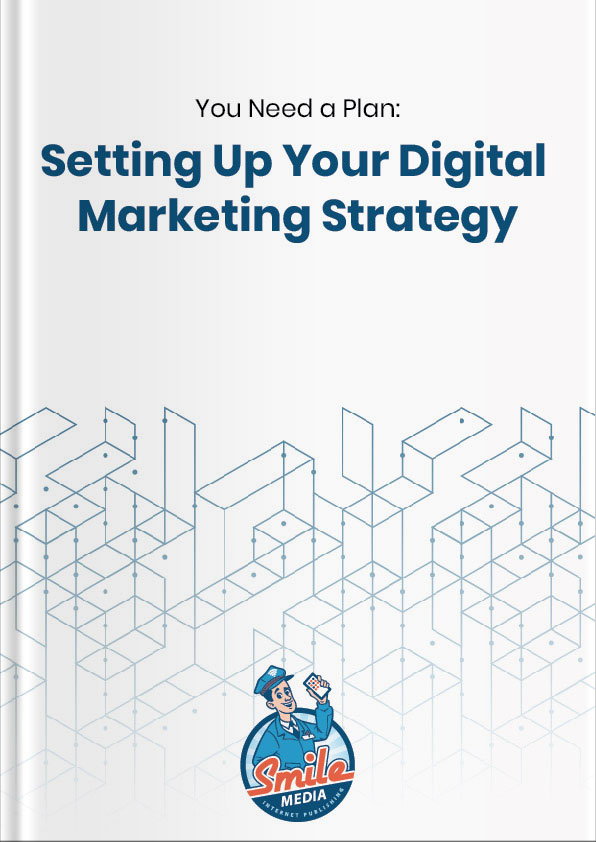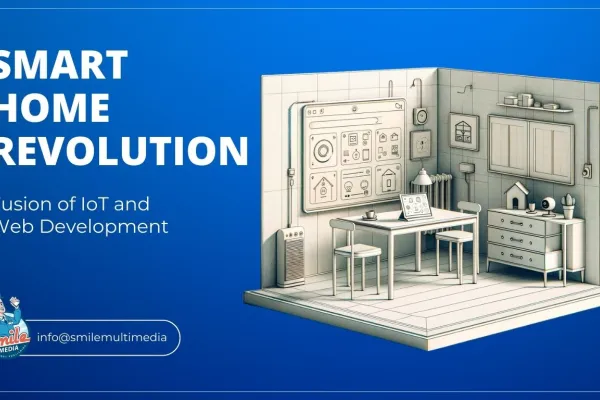In today's rapidly advancing digital landscape, mobile applications have emerged as a cornerstone of technological innovation, profoundly influencing how we communicate, work, and entertain ourselves. The ubiquity of smartphones has catapulted mobile apps to the forefront of the digital revolution, making them indispensable tools in our daily lives. From simplifying complex tasks to providing endless entertainment, the impact of mobile apps is undeniable.
At Smile MEDIA, we are acutely aware of the transformative power these applications hold. They are not just software running on a device; they are gateways to vast opportunities, connecting businesses with customers, friends with communities, and innovators with their audiences. Our mobile app development services lie in harnessing this power to bring your vision to life.
This mobile app development guide is more than just a roadmap; it's a journey through the intricate maze of app creation. We've crafted this guide with meticulous attention to detail, ensuring it serves as a comprehensive companion from the initial spark of your idea to the exhilarating moment of launching a successful app. Our mobile app development guide also addresses the crucial steps of testing, launching, and effectively managing your app post-launch.
Embrace this journey with Smile MEDIA, and let this guide to developing mobile apps transform your innovative idea into a digital reality that resonates with users worldwide.
Conceptualizing Your App Idea - Turning Dreams into Digital Realities
As you embark on the transformative journey of app development, it's crucial to lay a solid foundation by thoroughly conceptualizing your app idea. This process involves a series of strategic steps, from identifying a unique market need and understanding user pain points to analyzing current market trends and defining your target audience.
Identifying a Market Need
Every groundbreaking app starts with the identification of a unique market need. This crucial first step involves in-depth market research to uncover gaps and opportunities. Analyze what competitors offer and envision how your app can provide something better or different. This foundational stage is vital for creating an app that is not only innovative but also in demand.
Understanding User Pain Points
To create an app that truly resonates with users, it's essential to understand their challenges and pain points. Engage with potential users through surveys, interviews, or focus groups. Gathering this insight helps tailor your app to address specific problems or needs, making it a valuable tool for your target audience.
Analyzing Market Trends
Staying abreast of current market trends is crucial. What are the emerging technologies? What types of apps are gaining popularity? Understanding these trends can inspire innovative features and functionalities for your app, ensuring it's not just relevant today but also adaptable for the future.
Defining Target Audience and App Objectives
Clearly defining your target audience is a cornerstone of successful app development. Determine the demographics, behaviors, and preferences of your potential users. Align your app's objectives with the needs and desires of this audience. This alignment is key to developing an app that will find its place in the market.
Setting Clear Goals and Objectives
Establish clear, measurable goals for your app. What problem does it solve? How does it benefit the user? What are your business objectives? Setting these goals early on provides a clear direction for your app development journey and helps in measuring success post-launch.
Validating the App Idea
Before diving into development, validate your app idea. This can be done through market research, creating a minimum viable product (MVP), or seeking feedback from industry experts. Validation helps in ensuring there is a market for your app, saving time and resources in the long run.
Planning and Strategy - Blueprinting Your Path to Success
As you embark on the journey of app development, the "Planning and Strategy" phase is your foundational step towards a successful launch. This crucial stage encompasses everything from in-depth market research and competitor analysis to choosing the right platform, setting clear objectives, budgeting effectively, and crafting a robust monetization strategy.
Market Research and Competitor Analysis
Conducting thorough market research is the first step in understanding the current trends, user preferences, and gaps in the market. Analyze your competitors meticulously to identify their strengths, weaknesses, and strategies. This information is invaluable in carving out a unique position for your app in the market. It helps in understanding what works, and what doesn’t, and how you can differentiate your app to offer something truly valuable to users.
Choosing the Right Platform (iOS/Android)
Deciding whether your app will be developed for iOS, Android, or both is a critical decision. This choice should be guided by your target audience's preferences and behaviors. Each platform has its own set of guidelines, user expectations, and market penetration. For instance, iOS users tend to have higher engagement rates and willingness to spend, whereas Android dominates in global market share.
Setting Clear Objectives and Goals
Before diving into development, it's crucial to set clear objectives and goals for your app. What problem does it solve? How does it add value to the user? Goals could range from user acquisition targets to revenue milestones. Having clear objectives guides the development process and provides a benchmark for success.
Budgeting and Resource Allocation
Developing a mobile app requires careful budgeting and resource allocation. Determine the financial resources you are willing to invest and allocate them wisely across different stages of development, including design, development, testing, and marketing. Remember, quality should not be compromised for cost, as it can impact the overall success of your app.
Developing a Robust Monetization Strategy
A well-thought-out monetization strategy is essential for the financial success of your app. This could include in-app purchases, subscription models, advertisements, or a freemium model. The chosen strategy should align with your app’s purpose and user expectations, ensuring it adds value without compromising the user experience.
Designing the App - Crafting a Visually Stunning User Journey
In the realm of app development, the design phase is where creativity meets functionality, shaping the user's journey into an engaging and intuitive experience. This section explores the critical aspects of UX/UI design, wireframing, and prototyping, emphasizing the importance of meticulous attention to detail.
Importance of UX and UI
The user experience (UX) and user interface (UI) are pivotal in determining your app's success. A well-designed UX/UI not only captivates users but also simplifies their journey within the app. It's about creating an intuitive, user-friendly interface that makes interactions delightful and effortless. A great design can significantly increase user engagement and satisfaction, turning first-time users into loyal customers.
Wireframing and Prototyping
Wireframing lays the foundation of your app's design, offering a clear blueprint of its structure. It's a crucial step in visualizing the skeletal framework of your app. Prototyping, on the other hand, brings this blueprint to life, simulating user interactions and the app's functionality. This stage is vital for testing and refining the user experience, ensuring the final product is both functional and user-friendly.
Attention to Detail in Design
Every element in your app's design, from button placement to font choice, plays a role in the overall user experience. Attention to detail ensures that each aspect of the app is thoughtfully considered and contributes to a cohesive and engaging user interface. This meticulous approach to design can significantly enhance usability and aesthetic appeal.
Responsive and Adaptive Design
In a world where users access apps across a multitude of devices, responsive and adaptive design is essential. Your app should look and function flawlessly on different screen sizes and resolutions. This adaptability enhances user experience, ensuring that your app is accessible and appealing, regardless of the device used.
Incorporating User Feedback in Design
User feedback is a goldmine of insights for app design. Incorporating this feedback into your design process can lead to significant improvements in usability and user satisfaction. Regularly updating your app based on user reviews and suggestions shows that you value user input and are committed to providing the best experience possible.
Technical Aspects of App Development - Building the Backbone of Your Digital Dream
Navigating the technical landscape of app development is crucial for transforming your digital vision into reality. This section explores essential elements like choosing the right technology stack, developing a robust backend, crafting an engaging frontend, integrating APIs, and prioritizing security, all vital for building a successful and secure app.
Choosing the Right Technology Stack
Selecting the appropriate technology stack is a pivotal decision in app development. It's about finding the right balance between current trends and long-term viability. Consider your app's complexity, scalability needs, and security requirements. The technology stack should support your app's functionality today and its growth tomorrow.
Backend Development Essentials
A strong backend is the powerhouse of your app. It's responsible for managing databases, processing server-side logic, and ensuring seamless integration with other systems. A robust backend is crucial for handling user data securely and efficiently.
Frontend Development: Crafting the User Interface
Frontend development is where your app comes to life visually. It's about creating an engaging and intuitive user interface. This involves selecting the right frameworks and tools to build a responsive design that looks great across different devices and platforms.
API Integration and Management
APIs are the connectors that allow your app to communicate with other services and databases. Effective API integration is essential for enhancing your app's functionality and user experience. Managing these APIs efficiently ensures your app remains fast and reliable.
Security Measures and Data Protection
In an era where data breaches are common, prioritizing security in app development is non-negotiable. Implementing robust security measures and ensuring data protection should be integral parts of your development process. This includes encryption, secure authentication, and regular security audits.
Development and Testing - From Coding to Quality
Agile Methodology in App Development
Implementing agile methodologies is crucial for enhancing adaptability and efficiency in app development. Agile practices allow for iterative development, fostering a flexible and responsive approach. This methodology enables teams to incorporate feedback quickly and make continuous improvements, ensuring the final product aligns closely with user needs and market demands.
Quality Assurance and Testing Strategies
Quality assurance and rigorous testing form the backbone of successful app development. It's essential to conduct a variety of tests, including functional, performance, and security tests. These ensure that your app is not only reliable but also delivers a seamless user experience. A well-tested app is more likely to be positively received in the market.
User Experience (UX) Testing
User Experience testing is vital in ensuring your app meets the intended user needs and expectations. This involves testing the app's usability, accessibility, and overall user journey. By focusing on UX testing, you can identify any user interface issues and improve the overall user interaction with your app.
Continuous Integration and Deployment
Adopting continuous integration and deployment practices can significantly streamline the development process. This approach involves regularly merging code changes into a central repository, followed by automated testing and deployment. It helps in identifying and addressing issues early, reducing the time to market, and improving the quality of the app.
Beta Testing and User Feedback
Before the final launch, conducting beta testing is crucial. This involves releasing the app to a select group of users to gather real-world feedback. Beta testing helps in identifying any unforeseen issues and gauging user response, providing valuable insights that can be used to refine the app before its official release.
Ready for Liftoff: Launching Your App into the Market
Embarking on the final stages of your app's journey, it's time to shift focus towards making a memorable entrance into the market. This segment delves into the nuances of effective marketing strategies and App Store Optimization, ensuring your app not only debuts with impact but also continues to resonate with your intended audience.
Crafting an Impactful Pre-Launch Marketing Strategy
- Social Media Campaigns: Leverage platforms like Facebook, Instagram, and Twitter to build anticipation. Create engaging content that highlights your app's unique features.
- Email Marketing: Send out newsletters to your existing customer base and potential users. Include teasers, app screenshots, and launch date announcements.
- Influencer Collaborations: Partner with influencers who resonate with your target audience. Influencers can provide authentic endorsements and expand your reach.
- Content Marketing: Publish blog posts and articles related to your app's niche. This not only builds interest but also establishes your authority in the field.
- Promotional Events: Host webinars, online Q&A sessions, or virtual launch events to engage with your audience and create excitement.
Maximizing Visibility with App Store Optimization (ASO)
- Keyword Optimization: Research and use keywords that are most relevant to your app. These should be included in your app's title and description.
- Compelling App Description: Write a clear, engaging app description that highlights key features and benefits. Make it easy for users to understand what your app offers.
- High-Quality Visuals: Use eye-catching app icons and screenshots. Visuals play a crucial role in attracting users' attention in the app store.
- Preview Videos: Create short, engaging videos that showcase your app in action. Videos can be a powerful tool to demonstrate the user experience.
- Encouraging Reviews and Ratings: Plan to encourage early users to rate and review your app. Positive reviews and high ratings can significantly boost your app's visibility.
Post-Launch Strategies - Navigating the Post-Launch Universe
User Feedback and App Updates
After launch, actively seek user feedback and provide regular updates. This approach helps in refining your app based on real user experiences and keeping it up-to-date with the latest trends and technologies.
Marketing and Maintenance
Continued marketing efforts are essential for sustained success. Regular maintenance, including bug fixes and updates, ensures your app remains compatible with new devices and operating systems.
Wrapping Up
Set sail on your mobile app development journey with unwavering confidence. This comprehensive guide to mobile app development serves as your compass, providing the knowledge and insights required to successfully navigate the intricate process of app creation. Trust in Smile MEDIA for their mobile app development services to accompany you on this transformative voyage, where your innovative idea will be meticulously crafted into a thriving and impactful mobile application.
FAQs - Your Questions Answered!
- What is mobile app development, and why is it important?
Mobile app development is the process of creating software applications specifically designed to run on mobile devices. It's essential because mobile apps have become integral to our daily lives, offering convenience, accessibility, and a wide range of functionalities.
- How long does it take to develop a mobile app?
The development time for a mobile app can vary significantly based on complexity, features, and the development team's size. Simple apps may take a few months, while complex apps can take a year or more to develop.
- How can I identify a market need for my app idea?
Identifying a market need involves conducting thorough market research, understanding your target audience's pain points, and analyzing existing solutions to find gaps or areas where your app can offer improvement.
- How do I choose between iOS and Android for my app?
The choice between iOS and Android depends on your target audience and business goals. iOS generally has a more affluent user base, while Android has a broader user reach. Consider your audience's preferences and market share when deciding.
- How can I start my mobile app development journey?
Smile MEDIA offers expertise and guidance at every stage of your app development journey. From concept to launch, we provide services and solutions tailored to your unique needs, ensuring your app's success. Contact us for more details and consultation.










